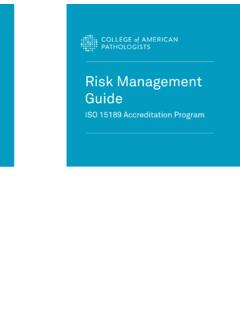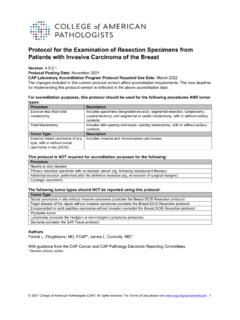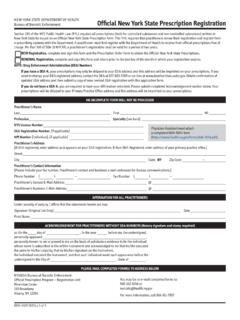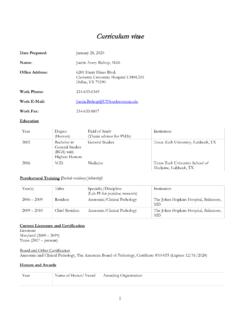Transcription of Practical Guide to Specimen Handling in Surgical Pathology
1 Practical Guide to Specimen Handling in Surgical Pathology Authors: Robert Lott, Janet Tunnicliffe, Elizabeth Sheppard, Jerry Santiago, Christa Hladik, Mansoor Nasim, Konnie Zeitner, Thomas Haas, Shane Kohl, Saeid Movahedi-Lankarani Version: Revised: April 2020 1 Practical Guide to Specimen Handling in Surgical Pathology AUTHORS: Robert Lott, Janet Tunnicliffe, Elizabeth Sheppard, Jerry Santiago, Christa Hladik, Mansoor Nasim, Konnie Zeitner, Thomas Haas, Shane Kohl, Saeid Movahedi-Lankarani INTRODUCTION In spite of the abundant guidelines and recommendations published for Specimen Handling and testing in a clinical Pathology laboratory, relatively little literature is available for guidance of Specimen Handling in a Surgical Pathology laboratory.
2 This document does not relate to cytologic or clinical Pathology samples. The following comprehensive table is intended to serve as a general guideline for proper Specimen Handling from the time it is taken from the patient to the time a completed slide of the Specimen is given to a pathologist for interpretation. DISCLAIMER: This document was created by members of the CAP/NSH Histotechnology Committee and is intended to serve as a guideline ONLY and NOT AN absolute recommendation for Specimen Handling . Each laboratory is advised to use these guidelines as a starting point and modify certain parameters to fit state and local institutional requirements, as appropriate.
3 Regulatory references, standards, and CAP checklist items cited in the guideline are current at the time of publication of this version of the guideline. It is recommended that the user confirm all references used are the latest version available. The use of the information contained in this guideline does not guarantee compliance with the CAP accreditation requirements or regulations from other accrediting organizations. Some information may be different or more stringent than the published CAP Checklists. It is the intent of the CAP/NSH Histotechnology Committee to update this document every 2 years or when required and have the updated version of the document available to members on the College of American Pathologists (CAP) and National Society for Histotechnology (NSH) websites.
4 Version: Revised: April 2020 2 Table of Contents: Part I Specimen Collection and Handling A. Patient Identification .. pg. 4 B. Proper Labeling .. pg. 5 C. Transport Media .. pg. 7 D. Completion of Requisition .. pg. 10 E. Recommendations for Tissue Collection and Handling .. pg. 17 F. Accessioning .. pg. 26 G. Handling prior to Gross Examination .. pg. 27 H. Intra-operative Consultation .. pg. 29 Part II Laboratory Processes A. Guidelines .. pg. 32 B. Tissue Cassette Identification .. pg. 38 C. Fixation Parameters .. pg. 39 D. Processing .. pg. 46 E. Embedding .. pg. 52 F. Microtomy.
5 Pg. 53 G. Staining .. pg. 58 H. Coverslipping .. pg. 71 Version: Revised: April 2020 3 VERSION REVISION DATE REVISION November , 2013 1. Addition of disclaimer on cover page 2. Addition of version control November , 2014 1. Revised per comments received from CAP Chair review January, 2015 1. Updated references CAP Checklists: ANP, COM, GEN , 4-21-2014 2. All references reviewed 3. Table of contents added September, 2015 1. Updated to reflect LAP Committee 2015 Checklist changes November, 2015 1. Updated to reflect corrected formalin solution to tissue ratio with references September, 2017 1.
6 Updated to reflect August 21, 2017 CAP Checklist edition changes September, 2018 1. Updated to reflect August 22, 2018 CAP Checklist edition changes 2. Updated to reflect review of all references April, 2020 1. Updated to reflect June 4, 2020 CAP Checklist edition Changes 2. Updated to reflect review of all references 3. Updated Table of Contents 4. Updated Title Page and organizational logos Version: Revised: April 2020 4 PART I I. Specimen COLLECTION and Handling Guideline Section Statement Related CAP Checklist Requirements 2018 Edition Additional References Collection and Handling A.
7 Patient Identification Patient is to be identified in a manner that respects patient privacy with respect to their medical records and medical data. Patient's identity must be verified at the time of Specimen collection. At least two acceptable patient-specific identifiers are required for patient identification: o Full name o Assigned identification number health record / master index number o Date of birth o Photo on government issued or other photo ID card, such as driver's license o Other specific personal identifiers Laboratory General Checklist, - Patient Confidentiality Laboratory General Checklist, - Patient Identification Laboratory General Checklist, Primary Specimen Container Labeling Health Insurance and Portability and Accountability Act (HIPAA).
8 Clinical Laboratory Standards Institute CLSI - GP33A, Accuracy in Patient and Sample Identification; 2011: Vol. 30 No7. International Standard ISO 15189:2012 - Medical Laboratories; section - Pre-examination Processes Version: Revised: April 2020 5 Collection and Handling B. Proper Labelling Specimen is labeled in the presence of the patient Specimen label must contain at least two patient-specific identifiers: o Full patient name o Assigned identification number health record / master index number o Date of Birth Customizable label elements additional identifiers that are acceptable: o Patient gender o Accession or requisition number o Ordering physician o Source of Specimen ( skin) o Site of Specimen ( left side of chest) Standardized format for label information should be implemented.
9 O Last name, first name o Date of Birth DD MMM- YYYY 12 MAR 1968 o Gender M, F, U ( unknown), T ( Transgender), I (Intersex) Written documentation developed for the correct positioning of the label on the collection container. o Do not attach label to the container lid (in whole or part) Laboratory General Checklist, Patient Identification Laboratory General Checklist, GEN. 40100 - Specimen Collection Manual Elements Laboratory General Checklist, GEN. 40491 - Primary Specimen Container Labeling All Common Checklist, Primary Specimen Container Labeling All Common Checklist, - Secondary Specimen Container Labeling Clinical Laboratory Standards Institute CLSI Auto12-A Specimen Labels: Content and Location, Fonts and Label Orientation: 2011: Vol.
10 31 No7. Brown RW, Della Speranza V, Alvarez JO, et al. Uniform labeling of blocks and slides in Surgical Pathology : Guideline from the College of American Pathologists Pathology and Laboratory Quality Center and the National Society for Histotechnology. Arch Pathol Lab Med. 2015;139(12):1515-24. Version: Revised: April 2020 6 o Do not overlap label resulting in patient data being covered Written documentation for the correction of labelling errors to be followed when specimens cannot be replaced All subsequent labelling of patient samples (blocks and slides) must follow same patient-specific identifying process.















